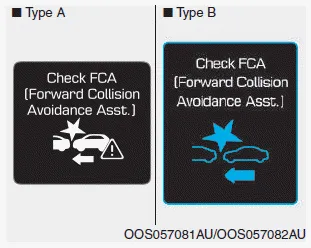Hyundai i30 (PD): Forward collision-avoidance assist (FCA) system - sensor fusion type (front radar + front camera) / System malfunction

Check FCA (Forward Collision Avoidance Asst.)
- When the FCA is not working properly,
the FCA warning light (
 )
will illuminate and the warning
message will appear for a few seconds.
After the message disappears,
the master warning light
(
)
will illuminate and the warning
message will appear for a few seconds.
After the message disappears,
the master warning light
( ) will illuminate. In this
case, we
recommend that you have the vehicle
inspected by a HYUNDAI
authorised repairer.
) will illuminate. In this
case, we
recommend that you have the vehicle
inspected by a HYUNDAI
authorised repairer. - The FCA warning message may appear along with the illumination of the ESC (Electronic Stability Control) warning light.
WARNING
- The FCA is only a supplemental system for the driver's convenience. The driver should hold the responsibility to control the vehicle operation. Do not solely depend on the FCA system. Rather, maintain a safe braking distance, and, if necessary, depress the brake pedal to reduce the driving speed.
- In certain instances and under certain driving conditions, the FCA system may activate unintentionally. This initial warning message appears on the LCD display with a warning chime. Also, in certain instances the front radar sensor or camera recognition system may not detect the vehicle or pedestrian ahead. The FCA system may not activate and the warning message will not be displayed.
- Even if there is any problem with the brake control function of the FCA system, the vehicle’s basic braking performance will operate normally. However, brake control function for avoiding collision will not activate.
- If the vehicle in front stops suddenly, you may have less control of the brake system. Therefore, always keep a safe distance between your vehicle and the vehicle in front of you.
- The FCA system may activate during braking and the vehicle may stop suddenly shifting loose objects toward the passengers. Always keep loose objects secured.
- The FCA system may not activate if the driver applies the brake pedal to avoid a collision.
- The FCA system may not activate according to the road conditions, inclement weather, driving conditions or traffic conditions.
- The brake control may be insufficient, possibly causing a collision, if a vehicle in front abruptly stops. Always pay extreme caution.
- Occupants may get injured, if the vehicle abruptly stops by the activated FCA system. Pay extreme caution.
WARNING
- The FCA system does not operate when the vehicle is in reverse.
- The FCA system is not designed to detect other objects on the road such as animals.
- The FCA system does not detect vehicles in the opposite lane.
- The FCA system does not detect cross traffic vehicles that are approaching.
- The FCA system cannot detect the driver approaching the side view of a parked vehicle (for example on a dead end street.)
In these cases, you must maintain a safe braking distance, and if necessary, depress the brake pedal to reduce the driving speed in order to maintain a safe distance.
â– Front radar â– Front camera In order for the FCA system to operate properly, always make sure the sensor cover or sensor is clean and free of dirt, snow, and debris.
The Forward Collision avoidance assist (FCA) system system is designed to monitor the vehicle ahead or a pedestrian in the roadway through radar signals and camera recognition to warn the driver that a collision is imminent, and if necessary, apply emergency braking.
Other information:
Hyundai i30 (PD) 2018-2024 Owner's Manual: Maintenance when towing a trailer
Your vehicle will need service more often when you regularly pull a trailer. Important items to pay particular attention to include engine oil, automatic transmission fluid, axle lubricant and cooling system fluid. Brake condition is another important item to frequently check.
Hyundai i30 (PD) 2018-2024 Owner's Manual: Interior care
Interior general precautions Prevent chemicals such as perfume, cosmetic oil, sun cream, hand cleaner and air freshener from contacting the interior parts because they may cause damage or discoloration. If they do contact the interior parts, wipe them off immediately.
Categories
- Manuals Home
- Hyundai i30 Owners Manual
- Rear combination lamp bulb replacement
- Shift-lock system. Shift-lock release
- Front fog lamp
- New on site
- Most important about car
